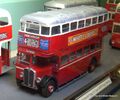Category:Thomas Tilling Ltd
Thomas Tilling (1825-1893) purchased a single horse-drawn bus in 1850, and rapidly expanded the business until it became London's largest provider of horses and horesdrawn vehicles. Tilling's successes included getting the contract for training the horses for the new 1866 Metropolitan Fire Brigade.
In 1897, Thomas' sons and son-in-law turned the business into a limited company, Thomas Tilling Limited.
1909: agreement with General Omnibus
Tilling's agreement with the London General Omnibus Company LGOC meant that while Tilling was able to continue operating independently in London (in conjunction with the LGOC), it needed to look outside London for expansion.
1920s
Tilling's main competitor British Electric Traction (BET) were in a similar situation, and its British Automobile Traction (BAT) subsidiary bought a number of local bus companies, with Tilling also being a part-investor. Tilling and BAT's intimate relationship led to BAT being renamed Tilling & British Automobile Traction Ltd (TBAT).
The 1924 grouping of most of the railway network into the "Big Four" railway companies eventually led to some rationalisation – although the rail companies had initially been keen to acquire business interests in anything to do with transport, from bus companies to shipping, aircraft, hotels, house-moving services and holiday companies, the amount of natural crossover and networking between bus and rail services was limited, and during the 1920s the rail companies divested themselves of most of their interests in bus services, with Tilling and TBAT acquiring these companies in exchange for shares.
1930s
The creation of London Transport in 1933 (in the shape of the London Passenger Transport Board) nationalised most large London-based public transport companies into a single entity, and Tilling's 328 buses working services in South London were compulsorily purchased. Tilling responded by buying the Royal Blue luxury coach service that operated over much of southern and Western England, in 1935.
1940s and 1950s
When the 1947 Transport Act resulted in the nationalisation of most British railway companies in 1948, their shareholdings in Tilling that had been acquired in the 1920s moved into public ownership, and Tilling effectively became publicly owned – the remainder of shares in Tilling's London private hire business was sold to the British Transport Commission (BTC) (which then owned "Tilling BTC" outright). British Electric Traction (BET) became about 50% owned by the BTC, and in 1967 BET sold its bus interests to the BTC's successor, after which these became a substantial part of the new National Bus Company in 1968.
The remaining non-bus businesses continues as "Tilling Group", which ended up owning a portfolio of companies that included the publisher Heinemann, Pilkington, and Cornhill Insurance.
Subcategories
This category has only the following subcategory.
T
- Tilling petrol-electric vehicles (2 P, 4 F)
Pages in category ‘Thomas Tilling Ltd’
The following 5 pages are in this category, out of 5 total.
B
Media in category ‘Thomas Tilling Ltd’
The following 8 files are in this category, out of 8 total.
- Brighton Hove and District AEC-Tilling petrol STL-Type No4 bus, angled (Ken Allbon).jpg 1,600 × 1,330; 708 KB
- Brighton Hove and District AEC-Tilling petrol STL-Type No4 bus, side (Ken Allbon).jpg 2,000 × 1,125; 929 KB
- Thomas Tilling petrol-electric bus, early, angled (Ken Allbon).jpg 1,600 × 1,600; 762 KB
- Thomas Tilling petrol-electric bus, early, side (Ken Allbon).jpg 2,000 × 1,125; 1.18 MB
- Thomas Tilling petrol-electric bus, later, angled (Ken Allbon).jpg 2,400 × 1,713; 1.23 MB
- Thomas Tilling petrol-electric bus, later, side (Ken Allbon).jpg 1,800 × 1,014; 954 KB
- Tilling Electrobus, Kemp Town No3 (Ken Allbon).jpg 1,200 × 800; 549 KB
- Tilling Electrobus, Kemp Town No3, front angle (Ken Allbon).jpg 901 × 1,200; 601 KB










